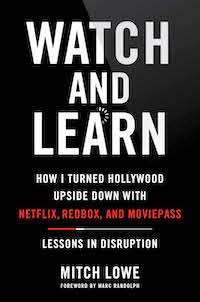By now I had fully bought into Netflix. This was my chance to make something notable happen, and I was in the thick of solving the company’s problems.
We were moving fast and slow at the same time. We had built a working online video rental and sales store. You could set up your account with a credit card and a mailing address. You could rent a film for a week for $4.99 or buy one at a cost that rivaled Walmart.
Our strategy was to build a large pool of DVD consumers who got enormous value and would be open to our next DVD offering. The eventual plan was to use DVD rental as a first step in building an entertainment portal that would attract consumers for movie news, cinema tickets, and DVD sales and rentals, and then generate revenue off those eyeballs. We didn’t exactly know what that would be, but we had this aura of confidence that came from working with incredibly diverse and creative people all focused on “figuring it out.”
Mitch Lowe
My job was evolving. I began with content acquisition and operations plus introductions to the entertainment companies. Then I handed operations over to our COO, Tom Dillon, and spent more time with DVD manufacturers and retailers in an effort to use their marketing muscle to promote Netflix. I continued and enhanced the early partnerships Netflix co-founder Marc Randolph had created with Sony, and I expanded our promotional plan to include manufacturers of 95 percent of all DVD players.
The DVD manufacturers inserted our coupon on top of the player in the box so that when the customer opened the box to install the player, the first thing they would see is our coupon. This was perfect since the consumer’s first question was, “What shall I watch?” At this time, Blockbuster did not rent DVDs in every store, and where they did, it was a very small selection.
“Our problem was, how we distinguished ourselves from the competition [...]?”
The manufacturers not only inserted the coupon for free but also promoted Netflix in store, in print ads, and wherever they could. The cost to us was supplying the free rentals, all in the hope that many of those free-trial customers would convert to paying for the service.
Our problem was, how we distinguished ourselves from the competition, which at that point was in only two facets of value: home delivery and an extensive catalog of long tail titles. Many customers were lukewarm about that, since they said they actually liked going to video stores that were typically near their home or other stores they were visiting anyway and most customers just wanted the big hit titles.
After returning the last of the free rentals, most customers went back to their Blockbuster or Hollywood Video store. What could we do to stay top of mind? We tried pop-ups on the internet, which were in their infancy and annoying. We created a plastic Netflix-branded DVD rack you could place on your TV. Nothing seemed to work and we were starting to get desperate for an improvement to our model that would truly convert our customers.
How We Launched Netflix’s Subscription Service
The big innovation began one day in the summer of 1999, as the executive team was touring the San Jose warehouse and discussing the failure of all these Band-Aids applied to create real stickiness for our service. I remember Netflix CEO Reed [Hastings] looking at all the boxes of DVDs and turning to the seven or so of us and saying, “What are all these DVDs doing here in the warehouse where they aren’t doing us any good? Shouldn’t they be at our customers’ homes?” And with that, the leaders each went off to see how we could move the inventory as close to the customers sitting in their homes ready to watch. I believe the history of all sales has been, the faster you can satisfy a customer need from the moment they want your product to the time they can use it, the more you succeed.
First, Marc and the store team came up with the subscription concept that would give each customer four movies of their choice to have at home ready to watch any time (solving the immediacy issue); they could return them one at a time and within days receive another movie of their choice. Marc’s team also came up with the queue that the customer would use to list films they wanted to see, so when Netflix received one of the four DVDs back it would pick the next in-stock movie from the customer’s queue and send it right away (solving the shopping fatigue problem). We delivered all of this for the cost of about four movies at Blockbuster.

The big, big win was “No Late Fees.” Blockbuster was a $5-billion-a-year business in the United States known for entertainment, yet it was in the top ten most hated brands because of fees it charged when you returned a movie late. With our queue system, there were never any late fees.
The system for subscriptions and the queue were built in a matter of months and were ready to launch in September 1999. But there were a couple of big problems. Since every time we mailed another DVD we incurred about $1.20 in shipping and supplies, and since most DVDs cost around $18, what would happen if the average subscriber saw fifteen movies a month, which you could easily do if you mailed back all four movies every six days? We would spend $18 just on mailing, not to mention cost of goods and labor on what was a $19.95 monthly subscription. And we were very convinced consumers would not accept anything with higher pricing.
With that fear in mind, we launched this new Netflix subscription to a small number of customers. Since there was no social media at the time, it was mostly a stealth product launch, which gave us four or five months to measure consumption.
Committing to the Subscription Model
By January it was clear that on average, consumption was acceptable at between six and seven DVDs a month. That brought on probably the biggest and hardest decision the Netflix leadership team had to make. Do we offer both our weekly à la carte rental service, which was doing tens of millions of dollars in revenue, and add in the subscription? Or do we kill the à la carte rentals and just offer subscription? And what about sales of DVDs? Do we continue that as a service and to keep our customers out of our competitors’ stores? And what about all the credits stored on our customers’ accounts for free rentals based on their DVD player purchase?
“Let’s do what we can do better than anyone else.”
Reed, as always, made decision-making as close to a science as anyone I ever met. “Let’s do what we can do better than anyone else” was his guidance, and not for the first time. “No one else is doing DVD subscription. It’s working. Let’s only do that and stop doing à la carte rental and sales.” And with that, the decision was made.
Basically, it worked. The hockey stick growth had begun.
***
Excerpted from the book Watch and Learn: How I Turned Hollywood Upside Down with Netflix Redbox, and MoviePass — Lessons in Disruption. Copyright © 2022 by Mitch Lowe. Published by Hachette Go, an imprint of Hachette Books, a division of Hachette Book Group, Inc. All rights reserved.





